
|
|
The Model QH-50C DASH
| |||||||||||||||||||||||||||||||||||||||||||||||||||||||||||||||||||||||||||||||||||||||||||||||||||||||||||||||||||||||||||||||||||||||||||||||||||||||||||||||||||||||||||||||||||||||||||||||||||||||||||||||||||||||||||||||||||||||||||||||||||||||||||||||||||||
| FRAM I - Less extensive as FRAM II and more of a reconstruction, FRAM I included installation of both ASROC and DASH. FRAM-I required the destroyer to lose one of it's twin 5-inch gun mounts. FRAM I extended the life of a destroyer by about 8 years. | |
| FRAM-II - developed primarily for the Sumners class, it was mostly a modernization program, however, not all Sumners were "FRAM'd (20) and not all Sumners that were, received DASH. FRAM II extended the life of a destroyer by about 5 years |
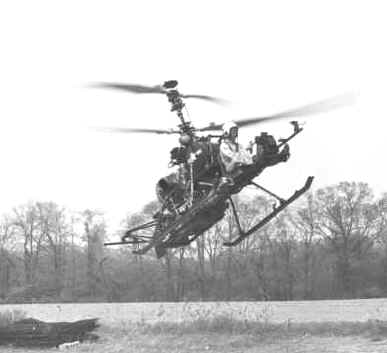 While the U.S. Navy began their FRAM programs to update their
destroyers, Gyrodyne received the authorization to proceed with the development
of the QH-50C DASH by the Navy on February 4, 1960 under Contract NOw 60-0099-c
and to supply the Navy with Two QH-50C aircraft for R & D purposes.
While the U.S. Navy began their FRAM programs to update their
destroyers, Gyrodyne received the authorization to proceed with the development
of the QH-50C DASH by the Navy on February 4, 1960 under Contract NOw 60-0099-c
and to supply the Navy with Two QH-50C aircraft for R & D purposes.
The development of the QH-50C, although an extension of
its QH-50A/B helicopters, was in fact, a completely different aircraft. Mating a
255 SHP turbine engine to a transmission where only twin 72 hp piston engines
had been, required extensive engineering and machining, but the need was
immediate and the rush
was on to build not just a prototype, but a production model under the
guidelines of the Navy's "Concurrent Development and Production"
program. By April 1, 1960,
the Navy awarded Gyrodyne contract NOw 60-0154c to supply an additional 15
QH-50C drones for the proposed testing and evaluation phase of DASH. Within 1
year and 2 months and 2 days of the original development contract, the first
flight of the QH-50C with a safety pilot took place on April 6, 1961 (as
seen upper-left).
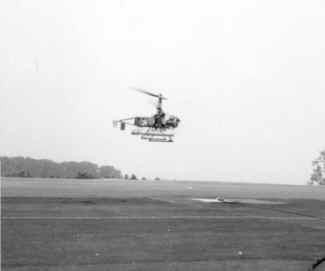
Without a safety pilot, the first remotely controlled flight of the QH-50C occurred at Patuxent River, MD, on January 25, 1962; as seen at right.
To illustrate the urgency of
the DASH program for the Navy's stand-off weapons needs, the Navy granted it's
production authorization on April 4, 1960: some two (2)
months after the R & D go-ahead and ONE YEAR before
the first model had actually even flown! To make matters worse,
the Naval shipyards were a full three years ahead of schedule,
causing completely refurbished FRAM'd Destroyers to go to sea without the DASH
system that they had been extensively modified to operate in the first place.
This "ship-to-drone gap" together with the stand-off
capabilities previously demonstrated by the QH-50A/B models created a strong
pressure on the Navy and on Gyrodyne to expedite development and delivery of the
QH-50C drones.
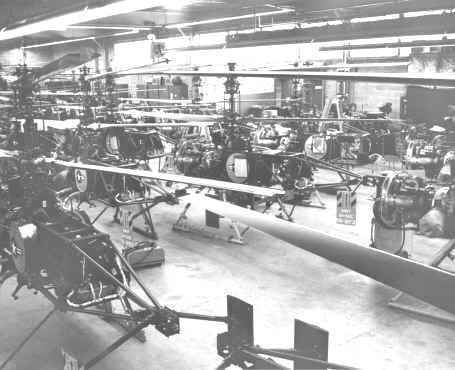 This
pressure caused production to slip as developmental problems occurred with the
Navy's "off-the-shelf" flight control system. These problems began to
occur in test and on the production line (seen left). Despite the initial order of Two QH-50C
drones not having being delivered by the December 1960 deadline and therefore
the flight testing not having yet begun, the Navy nevertheless ordered an
additional 42 PRODUCTION model QH-50C aircraft for fleet use. In the
following 35 months, the QH-50C test program was conducted and did reveal many
deficiencies of the Drone. Gyrodyne proposed several modifications to the
"in-testing" drones, but such action would have halted the production
line. The Navy declined the contract to modify the aircraft on the line as well
as aircraft already delivered.
This
pressure caused production to slip as developmental problems occurred with the
Navy's "off-the-shelf" flight control system. These problems began to
occur in test and on the production line (seen left). Despite the initial order of Two QH-50C
drones not having being delivered by the December 1960 deadline and therefore
the flight testing not having yet begun, the Navy nevertheless ordered an
additional 42 PRODUCTION model QH-50C aircraft for fleet use. In the
following 35 months, the QH-50C test program was conducted and did reveal many
deficiencies of the Drone. Gyrodyne proposed several modifications to the
"in-testing" drones, but such action would have halted the production
line. The Navy declined the contract to modify the aircraft on the line as well
as aircraft already delivered.
The first operational drones were delivered to the fleet when a QH-50C was remotely flown from San Clemente Island, California out to the destroyer USS Buck (DD-761) on November 15, 1962. It had been only 2 years, eight months and one week after the award for the development contract.
Unfortunately, from November 1962 to January 1963, 27 QH-50C drones were lost and the trend showed that further losses would occur if the deployed aircraft were not fixed. The Navy agreed to a mandatory grounding in January 1963.
The major problem dealt with
the altitude axis of the automatic flight control system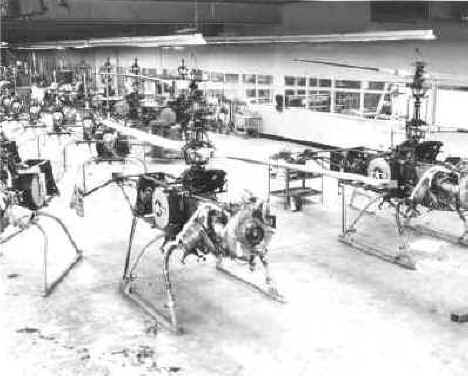 which had been designed to use a Government-furnished (GFE) radar altimeter.
With the vendor responsible for the GFE radar altimeter not complying with the
goals of the program and no other source available at that time for installation
in a remote controlled helicopter, other methods had to be investigated for
stabilization of the altitude axis. In January 1963, Gyrodyne requested that all
QH-50C aircraft be grounded until the problem could be solved.
which had been designed to use a Government-furnished (GFE) radar altimeter.
With the vendor responsible for the GFE radar altimeter not complying with the
goals of the program and no other source available at that time for installation
in a remote controlled helicopter, other methods had to be investigated for
stabilization of the altitude axis. In January 1963, Gyrodyne requested that all
QH-50C aircraft be grounded until the problem could be solved.
Gyrodyne then initiated a crash program to solve the problem by using a barometric altimeter. This led to the development of a static source mounting assembly on the top of the upper rotor drive shaft. The concept of the installation is so unique that it not only solved the vertical axis problem for the QH-50C, but it turned out to be a patentable item in which Gyrodyne received patent no. 3,347,095.
By June 6, 1963, the problem with the "stabilization of the altitude axis" had been solved and the Navy ordered an additional 127 QH-50C aircraft and the production line began to move once again. On February 1964, the Navy placed an additional order for 185 QH-50C aircraft.
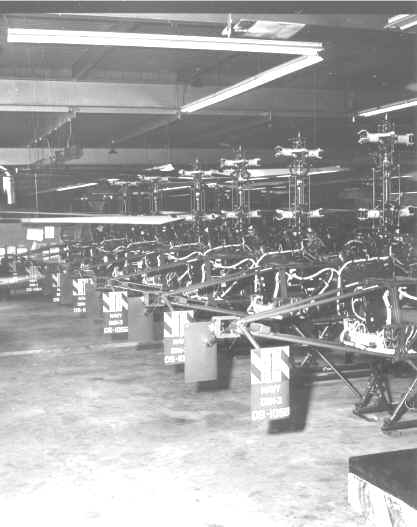 There is no question that the Navy's rush to field the QH-50C
resulted in inadequate testing and evaluation. This lack of testing of the GFE
automatic flight control system coupled to the coaxial platform resulted in
drone losses. It should be pointed out, that these losses were NOT due to the
airframe, but rather the obsolete radio-controlled automatic flight control
system the Navy insisted upon using.
There is no question that the Navy's rush to field the QH-50C
resulted in inadequate testing and evaluation. This lack of testing of the GFE
automatic flight control system coupled to the coaxial platform resulted in
drone losses. It should be pointed out, that these losses were NOT due to the
airframe, but rather the obsolete radio-controlled automatic flight control
system the Navy insisted upon using.
Irregardless, the belief that the increased range of
operations of the ASW QH-50C drone would create such a deterrence effect on
Soviet sub commanders that it was felt that the benefits outweighed the risks of
possible losses and that fielding the Drone for that effect had value; even if
the Drone needed to be updated on the destroyer it flew from.
In April 1964, the Navy
directed Gyrodyne to reconfigure 4 QH-50C drones on the production line (seen
left) to
overcome the problems associated with lacking all-weather capability and to
increase guidance accuracy. Those aircraft would become the QH-50D
and the most versatile variant of the QH-50 series of drones. With the
introduction of the QH-50D to the fleet in mid 1965, the Navy began to replace
the lower powered and more troublesome QH-50C with the improved D model.
By 1970, 139 of the 142 surviving QH-50C drones
of the original 378 produced had been removed from fleet destroyers and
placed in storage. At that time, the QH-50C drones were being retained as a contingency
reserve for use in the event of a national emergency. By 1980, all the QH-50C
drones in storage had been transferred to the following facilities to act as
either missile targets or target towing vehicles:
|
Naval Air Warfare Center (NAWC)-China Lake, California | |
|
Naval Air Warfare Center (NAWC)-Pt. Magu, California | |
|
U.S. Army Simulation, Training and Instrumentation Command's Target Management Office (US ARMY STRICOM-TMO), White Sands, New Mexico |
By 1998, the U.S. Army's Program Executive Office, Simulation, Training and Instrumentation (PEO STRI) was the sole user of the QH-50C, having acquired the China Lake assets during the base re-alignment program.
By 1970, all Sumners and Gearing class
destroyers had
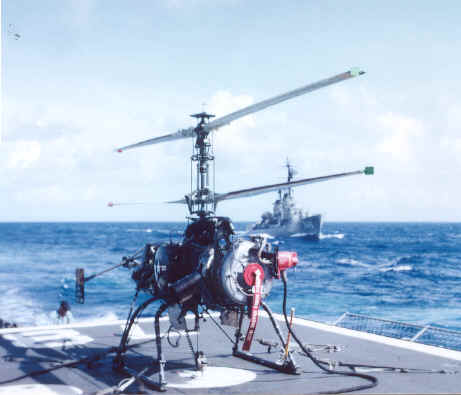 been
retired from the U.S. Navy and most transferred or sold to foreign countries,
such as Taiwan and Turkey to serve in their Navy. Although most of those ships
have since been scrapped, three examples of DASH equipped Destroyers survive today
as memorials. The USS
Laffey (DD-724), a Sumner class, is at Patriots Point Naval Museum,
Mount Pleasant, South Carolina with a DASH sitting on the flight deck. The USS
Joseph P. Kennedy Jr. (DD-850), a Gearing, is undergoing
restoration at Battleship Cove, Fall River, Massachusetts. The USS
Orleck (DD-886), a Gearing,
is also currently undergoing restoration by the Southeast Texas War Memorial and
Heritage Foundation, Orange, Texas. Although Orleck
and the Kennedy flew DASH and the surveillance
model of the QH-50D, called "SNOOPY" over Vietnam, Orleck
and the Kennedy museums are
restoring their ships to the time DASH flew in the ASW role. Both Orleck and Kennedy
have acquired a QH-50C and the ship based equipment for their ships and are
currently restoring their flight decks, hangars and aircraft. The USS
Laffey uses its hangar as a multi-destroyer with the QH-50C placed on
their flight deck. You can view our Museums page
to see where other QH-50's are exhibited.
been
retired from the U.S. Navy and most transferred or sold to foreign countries,
such as Taiwan and Turkey to serve in their Navy. Although most of those ships
have since been scrapped, three examples of DASH equipped Destroyers survive today
as memorials. The USS
Laffey (DD-724), a Sumner class, is at Patriots Point Naval Museum,
Mount Pleasant, South Carolina with a DASH sitting on the flight deck. The USS
Joseph P. Kennedy Jr. (DD-850), a Gearing, is undergoing
restoration at Battleship Cove, Fall River, Massachusetts. The USS
Orleck (DD-886), a Gearing,
is also currently undergoing restoration by the Southeast Texas War Memorial and
Heritage Foundation, Orange, Texas. Although Orleck
and the Kennedy flew DASH and the surveillance
model of the QH-50D, called "SNOOPY" over Vietnam, Orleck
and the Kennedy museums are
restoring their ships to the time DASH flew in the ASW role. Both Orleck and Kennedy
have acquired a QH-50C and the ship based equipment for their ships and are
currently restoring their flight decks, hangars and aircraft. The USS
Laffey uses its hangar as a multi-destroyer with the QH-50C placed on
their flight deck. You can view our Museums page
to see where other QH-50's are exhibited.
![]()
Today, there are about SIX surviving QH-50C's that are still used by the United States Army. These aircraft, originally built for Naval shipboard use, are achieving a 97% readiness rate in the deserts of New Mexico over the past 17 years. This rate is reported by the contractor operating the aircraft, for the U.S. Army's Program Executive Office, Simulation, Training and Instrumentation (PEO STRI). Although its torpedo delivery days are over, the QH-50C continues to be an active asset for the U.S. Military as a target towing vehicle in order to develop more precise missiles for the war fighter in the field.
There are 8 known examples of QH-50C that are available for viewing in museums.
PERFORMANCE SUMMARY |
||||||||||||||||||||||||||||||||||||||||||||||||||||||||||||||||||||||||||||||||||||||||||||||||||||||||||||||||||||||||||||||||||||||||||||||
|
Take-Off Loading Conditions-ASW Attack, Full Fuel |
||||||||||||||||||||||||||||||||||||||||||||||||||||||||||||||||||||||||||||||||||||||||||||||||||||||||||||||||||||||||||||||||||||||||||||||
QH-50C First flight of prototype w/safety pilot on April 6, 1961 with T50-BO-4 engine |
||||||||||||||||||||||||||||||||||||||||||||||||||||||||||||||||||||||||||||||||||||||||||||||||||||||||||||||||||||||||||||||||||||||||||||||
QH-50C First Remote Controlled Flight on January 25, 1962 at NATC, Patuxent River, MD |
||||||||||||||||||||||||||||||||||||||||||||||||||||||||||||||||||||||||||||||||||||||||||||||||||||||||||||||||||||||||||||||||||||||||||||||
| TAKE-OFF WEIGHT | 2303 LBS. |
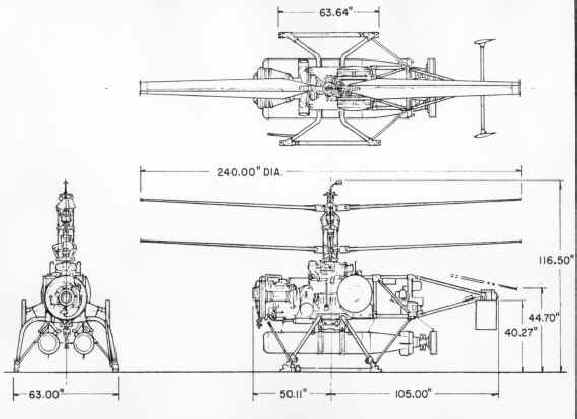
|
||||||||||||||||||||||||||||||||||||||||||||||||||||||||||||||||||||||||||||||||||||||||||||||||||||||||||||||||||||||||||||||||||||||||||||
| Fuel | 230 LBS. | |||||||||||||||||||||||||||||||||||||||||||||||||||||||||||||||||||||||||||||||||||||||||||||||||||||||||||||||||||||||||||||||||||||||||||||
| Payload | 866 LBS. | |||||||||||||||||||||||||||||||||||||||||||||||||||||||||||||||||||||||||||||||||||||||||||||||||||||||||||||||||||||||||||||||||||||||||||||
| Disc Loading | 7.33 lb/sq.ft | |||||||||||||||||||||||||||||||||||||||||||||||||||||||||||||||||||||||||||||||||||||||||||||||||||||||||||||||||||||||||||||||||||||||||||||
| Vertical Rate of Climb at S.L. | 1355 fpm | |||||||||||||||||||||||||||||||||||||||||||||||||||||||||||||||||||||||||||||||||||||||||||||||||||||||||||||||||||||||||||||||||||||||||||||
| Absolute hovering ceiling | 11,120 feet | |||||||||||||||||||||||||||||||||||||||||||||||||||||||||||||||||||||||||||||||||||||||||||||||||||||||||||||||||||||||||||||||||||||||||||||
| Maximum rate of climb at S.L. | 1845 fpm | |||||||||||||||||||||||||||||||||||||||||||||||||||||||||||||||||||||||||||||||||||||||||||||||||||||||||||||||||||||||||||||||||||||||||||||
| Service ceiling | 16,200 feet | |||||||||||||||||||||||||||||||||||||||||||||||||||||||||||||||||||||||||||||||||||||||||||||||||||||||||||||||||||||||||||||||||||||||||||||
| Speed at S.L. | 80 knots | |||||||||||||||||||||||||||||||||||||||||||||||||||||||||||||||||||||||||||||||||||||||||||||||||||||||||||||||||||||||||||||||||||||||||||||
| Max. Speed/alt. | 80 knots/S.L. | |||||||||||||||||||||||||||||||||||||||||||||||||||||||||||||||||||||||||||||||||||||||||||||||||||||||||||||||||||||||||||||||||||||||||||||
| Combat Range | 70.65 n. miles | |||||||||||||||||||||||||||||||||||||||||||||||||||||||||||||||||||||||||||||||||||||||||||||||||||||||||||||||||||||||||||||||||||||||||||||
| Cruise Altitude | Sea Level | |||||||||||||||||||||||||||||||||||||||||||||||||||||||||||||||||||||||||||||||||||||||||||||||||||||||||||||||||||||||||||||||||||||||||||||
| Vert. Rate of Climb at S.L. at 90 degrees | 475 fpm | |||||||||||||||||||||||||||||||||||||||||||||||||||||||||||||||||||||||||||||||||||||||||||||||||||||||||||||||||||||||||||||||||||||||||||||
| Ordnance | MK-44 Torpedo (2) | |||||||||||||||||||||||||||||||||||||||||||||||||||||||||||||||||||||||||||||||||||||||||||||||||||||||||||||||||||||||||||||||||||||||||||||
| Ordnance load II | MK-46 Torpedo (1) | |||||||||||||||||||||||||||||||||||||||||||||||||||||||||||||||||||||||||||||||||||||||||||||||||||||||||||||||||||||||||||||||||||||||||||||
|
|
|||
General Arrangement QH-50C Drone |
|||
| 1. Tip brakes | 6. Rotor brake | 11. Tail surfaces | 16. Engine (T50) |
| 2.Upper rotor | 7. Airborne generator | 12. Fuel tank | 17. Electromechanical rotary actuator |
| 3. Static Pressure pick-up assembly | 8. Transmission | 13. Landing gear | 18. Non-rotating controls |
| 4. Rotating Controls | 9. AFC set components | 14. Antenna | |
| 5. Lower rotor | 10. Aft fuselage | 15. Weapons (MK-44) | |
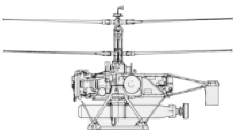
Serial Number HistoryQH-50C Drone (referred to DSN-3 prior to 1962) |
|||
Serial Numbers |
Number Produced |
Manufacture Date |
Disposition |
| N-300 | 1 | February 1961 | Model DSN-3, N-300 was assigned to ground testing as the first aircraft of its type, it had problems-from Feb to March 1961, the aircraft suffered from blade cracking and on May 18, 1961 with only 26 hours of running time, the first stage pinion bearing disintegrated. The bearing design was changed for all 4 R &D DSN-3 aircraft and N-300 returned to flight status on July 13, 1961. |
| N-301 through N-303 | 3 |
February through June, 1961 |
Used for R & D of the automatic flight control system, These early versions were "manned" DSN-3s and were subsequently used for parts, transmission run-in and engine test units and subsequently scrapped. |
| DS-1008 | 1 |
June 1961. |
DS-1008 originally was a semi-drone with manned provision using parts from N-303. That provision was later removed and the aircraft was rebuilt as a pure drone and delivered to the Navy in Feb. 1961. Used at Gyrodyne for Avionics R & D. Subsequently used for parts and scrapped |
| DS-1009 through DS-1192 | 184 |
July 1961 through October 1963. DS-1009 was the FIRST DSN-3 (QH-50C) built as pure drone. |
First 9 aircraft used for OPTEVFOR (Operational Evaluation). All subsequent production were delivered to U.S. Naval Fleet; 2 survive today in museums. |
| DS-1193 through DS-1196 | 4 |
October 1964 |
Returned to Gyrodyne: Converted into D models in January 1965; Used for testing, none survived. |
| DS-1197 through DS-1381 | 185 | Late October 1964 through December 1965 | Delivered to U.S. Naval Fleet; 7 survive today in museums. |
| DS-1382 | 1 | December 1965 | Returned to Gyrodyne: Converted into a D model in January 1965, becoming the first QH-50D to be built and delivered; It did not survive. |
| DS-1383 through DS-1385 | 3 | December 1965 | Delivered to the U.S. Navy, none survived. |

![]()
![]()
|
The name "Gyrodyne" in its stylized
form above, is the Trademark of and owned by the Gyrodyne Helicopter Historical
Foundation; unauthorized use is PROHIBITED by Federal Law. All Photographs, technical specifications, and
content are herein copyrighted and owned exclusively by Gyrodyne Helicopter
Historical Foundation, unless otherwise stated. All Rights Reserved
©2013. |